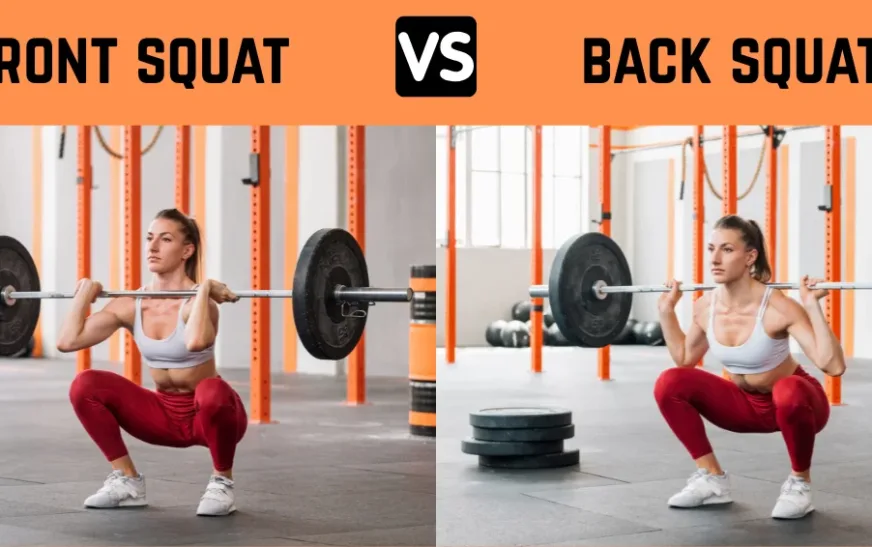
Squat is a compound exercise that is highly beneficial for building lower-body strength. From quads to glutes, calves, and core, they work it all.
However, when you add weight to this movement, especially with a barbell, an inevitable comparison is likely to arise. Should you put the weight in front of you and do a front squat, or put it behind you for a back squat?
The quick answer to this question is that both variations are effective. Still, there are a few key differences between them that you should be aware of. Understanding them will help you incorporate both types of squats more effectively in your workout routine and determine which is better in the context of front squat vs back squat training.
Exploring the Differences Between Front Squat and Back Squat
Both front and back squats are empowering strength moves. Let’s examine their differences closely.
In a back squat, the barbell is placed behind your shoulders. More specifically, it is put across the upper-back muscles and posterior shoulder muscles. In a front squat, the barbell is placed in front of your shoulders. Your elbows are extended, so the bar is placed on your front deltoids.
Read Also: Hack Squat Alternatives
Back Squat: A More Convenient Alternative
Are you new to squatting? Do you have limited mobility in your shoulders and wrists? Doing more back squats is ideal. This does not mean not to do front squats. But do less of them and build your strength and balance up to doing them more frequently.
For individuals with limited shoulder mobility, getting into the front squat position can be very uncomfortable. You should also avoid it if you have a shoulder injury. Back squats will strengthen the same muscles as front squats, without straining your upper body tissues.
The front squat position also requires wrist mobility. If you find it hard to bend your wrist back to make a 90-degree angle with your forearm and palm, you’ll be unable to perform front squats effectively. Back squatting is a good alternative here. These mobility considerations play a big role when deciding between front squat vs back squat exercises.
Front Squat: Safer for Your Knees and Back
Front squats are better suited for individuals with knee problems, such as meniscus tears. This may sound strange since these squats require you to bend your knees much more than back squats. However, researchers have found that front squats put less compressive force on the knee. So, they are good for maintaining long-term joint health.
The front squat requires you to stay in an upright position. For this, your erector muscles have to do more work. These muscles protect your spine. The more you strengthen them with front squats, the less your chances of experiencing back issues. If back problems are something that bothers you, incorporating more front squats can be beneficial.
Back Squat: The Fast Track to Strength Building
You can build strength effectively with both front and back squats. But back squats allow you to load more weight than front squats. This is due to the placement of the bar on your body.
In a front squat, increasing the weight will cause you to lean forward. This makes it very challenging to maintain an upright position. But in a back squat, the bar rests on your back. You don’t have to engage your arms and shoulders that much to hold the bar. The weight is centered over the base of the support. This lets you lift more without being pulled forward. Thus, you can add more weight without compromising the form.
Front Squat: Safer Overall Lift
While the back squat is easier to perform, the front squat offers greater safety benefits. This is because of the rear-loaded position of the back squat. It tempts even beginners to pack more weight than they can efficiently hold. Most commonly, they load up their barbell with more weight than they can handle. This makes their movement very dangerous. It also compromises their form.
This isn’t the case with the front squat. It forces the lifter to be precise. You need to understand the movement first and keep your core upright even when it’s being pulled forward. You cannot do so with a barbell loaded with more weight than you can hold.
Common Front Squat Mistakes to Avoid
To get the full benefits of front squats, you must do them correctly. Below are some common mistakes to avoid.
- Avoid rounding your upper back. Your upper back and your spine must be fully straight throughout the movement.
- Sit down on your heels when doing a front squat. If you don’t do that, you’ll just fall forward.
- Do not let your elbows drop. If your elbows drop, you will start to lean forward. This will compromise your form.
Read Also: Leg Press vs. Hack Squat
Common Back Squat Mistakes to Avoid
Back squats are more convenient than front squats. However, it’s common to see lifters committing mistakes while performing them as well.
- Do not shy away from going deep into the squats. You must ensure that your thighs are parallel to the floor. To make the movement more effective, try going even lower.
- Avoid letting your chest fall forward during the squat. This will disengage your posterior chain. Look straight ahead and keep your shoulders rolled back and down.
- Do not cave in your knees. Also, don’t move in a forward manner during the squat. Ensure that your knees stay in line with the top of your toes. They should not be further out.
Choosing Between a Front Squat and a Back Squat
In a well-rounded workout routine, you don’t choose between a front squat and a back squat. You incorporate both. However, how you do them is important.
As a best practice, beginners should start with back squats. When you feel fully comfortable with them, start incorporating front squats into your routine. Front squats are especially effective if you want to master advanced movements like Olympic lifts. They are also beneficial for muscles like the quads and the core.
To strengthen the posterior chain, focus on back squats. They effectively strengthen muscles like your glutes, hamstrings, and lower back.
Remember, a front squat demands more flexibility than a back squat. Back squats let you lift with more weight than a front squat. When evaluating front squat vs back squat, your decision should be based on your fitness goals, physical limitations, and training style.










